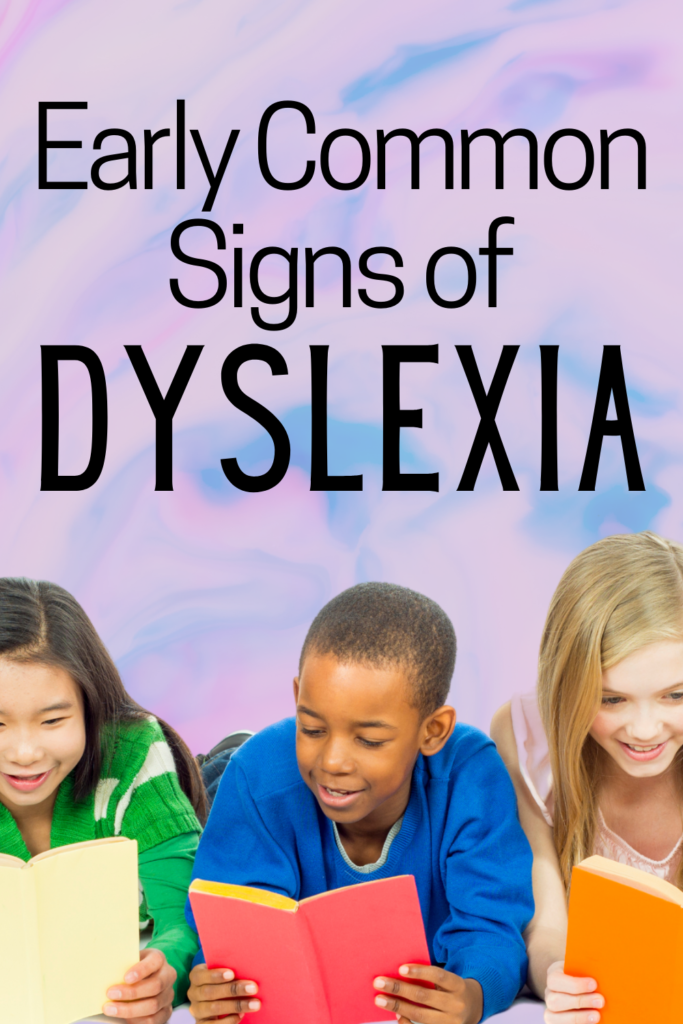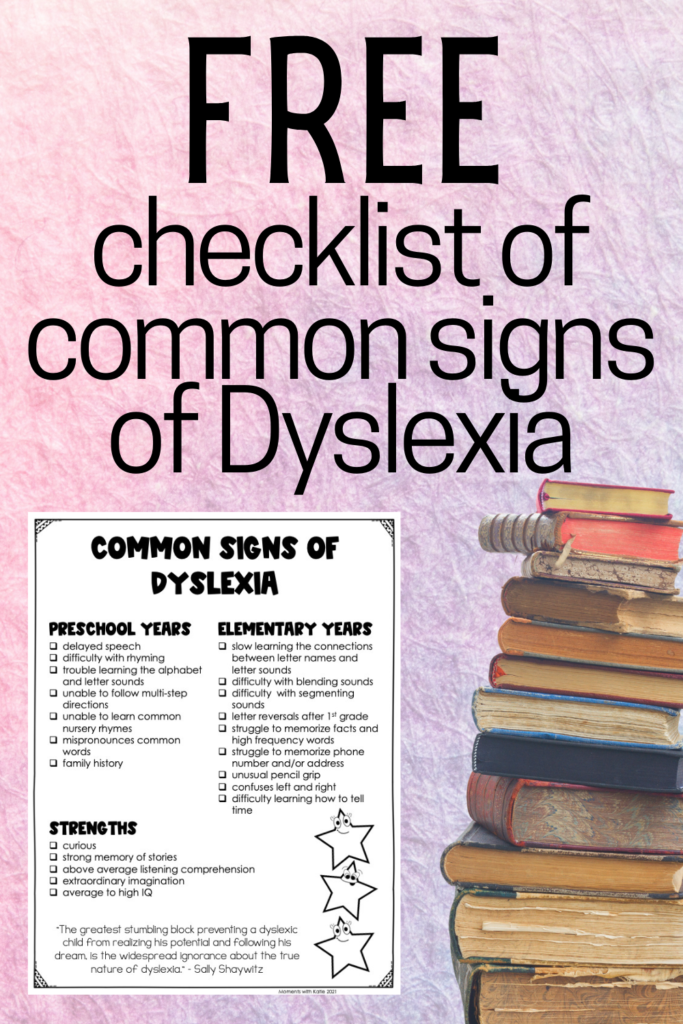There are many common early signs of dyslexia; research shows dyslexia can be identified before students even enter kindergarten. Early identification and proper intervention is critical for students with dyslexia. As a teacher with a masters degree in reading education, I knew before my son started kindergarten that something was different about his academic development. Unfortunately, I did not have the proper knowledge to accurately identify the cause.

There are multiple strengths and weaknesses parents can look for during the preschool years that are common early signs of dyslexia. It is also important to realize some of these weakness indicators are developmental and should not be used as an end all be all when identifying a child as dyslexic. I have included a more extensive checklist below that you can print and use with other children.
Weaknesses:
There are many weaknesses that are considered common early signs of dyslexia. These are 5 of the most noticeable signs I saw in Tanner:
1. trouble learning letter names and letter sounds
Many students enter kindergarten knowing their letter names and letter sounds. Tanner knew very few letter names and less than 5 letter sounds before starting kindergarten. He was unable to recognize any sight words. His inability to identify letter names and sounds was my biggest concern and his most noticeable early sign of dyslexia.
2. unable to recognize simple rhyming words
Tanner was unable to identify or create any rhyming words. I remember saying simple rhyming words, such as cat and hat, and he was unable to correctly connect the words as a rhyming pair. To this day, he struggles creating and identifying more complex rhyming words.
3. delayed speech and/or difficulty pronouncing words correctly
While many children say their first word prior to turning one, Tanner didn’t say any words, including “mommy,” until after his first birthday. When he started talking, he struggled to pronounce words correctly. His pediatrician even expressed concern and suggested I have his speech evaluated. He was evaluated twice before turning three, but both times only showed moderate delays in relation to his age. Due to this, he did not qualify for speech therapy.
I had him evaluated again when he was almost 4 by one of our local public schools and he qualified for speech therapy through the school district. He received an IEP and started attending speech services once a week at the school while attending VPK elsewhere. His IEP was transferred to his new school when he started kindergarten; he continued to receive services. Many students are able to be dismissed from speech by 3rd grade, but the school informed me he would likely need and qualify for speech until he left elementary school. He was making progress, but it was slow progress.
At the beginning of 3rd grade I had him evaluated by a private dyslexic specialist. She informed me his speech difficulties were likely due to his lack of phonemic awareness caused by dyslexia. After receiving Orton Gillingham instruction and explicit phonemic awareness instruction, all of his speech struggles have disappeared.
4. difficulty following multi-step directions
I actually didn’t recognize this as a “problem” early on, but looking back this sign was definitely visible. Tanner struggled remembering multiple directions, so I often just told him to do one thing at a time. For example, if I asked him to brush his teeth then put on pajamas, he would often brush his teeth and then return to where I was without putting on the pajamas. I made it a habit to only ask him to do one thing at a time.
5. family history
Dyslexia is genetic. If a parent struggled with reading in school, it is likely a child will struggle also. Tanner’s dad struggled in school growing up, which I believe is how he inherited his dyslexia.

Strengths
While many people focus on the weaknesses, there are also strengths that can be considered common early signs of dyslexia. These are some traits I noticed in Tanner early on.
1. curious
A lot of children go through a phase of asking “why” constantly, but a dyslexic child will stay excessively curious. Tanner has always wanted to know more about his surroundings and would often ask me questions I didn’t even know the answer to. He was very observant and noticed small details. Years later and he is still one of the most curious people I’ve ever met. He loves learning and is always searching YouTube to answer questions (because I still don’t know the answers).
2. extraordinary imagination
Once again, young children are often imaginative, but dyslexic children take it to a new level. Tanner was able to create stories about anything.
3. above average comprehension
This was a frustration for me at the beginning. I couldn’t understand why he could sit for long periods of time listening to me read and accurately recap the story, but struggled to identify letter names/sounds. I was reading chapter books at bedtime prior to 1st grade and he was always able to have lengthy discussions about the story and make predictions. His listening comprehension is still above grade level. In addition to bedtime stories, he now also uses LearningAlly to listen to books that are significantly above his reading level.
4. large vocabulary
I cannot remember when I identified this, but it was likely around kindergarten. While he did have a delay in speech, once he started talking and communicating he never stopped. He picks up on new words quickly and is able to easily determine meaning of unknown when used in context. Once he learns a new word, it becomes part of his vocabulary and he will use easily when appropriate. It sometimes surprises me the words he uses.
5. strong memory of stories
Tanner never forgets anything. I’ve always been surprised when he can easily recall an event that occurred years ago, especially at a young age.
My family actually jokes because of a situation that occurred a couple years ago. Tanner was about 7 and was at the grocery store with my dad. My dad was about to call my mom because he couldn’t find the gravy that was on her grocery list. Tanner immediately told him not to call and that it was “on aisle 6.” My dad played along and went to aisle 6 and sure enough it was on that aisle. Tanner said he remembered being at the store with my Mom once and she had to ask an employee what aisle it was on. Anytime Tanner remembers a random event now, we all laugh and say its an “aisle 6” moment.
While he is excellent at remembering stories, he struggles with basic facts. As noted before, he had a difficult time remembering letter names and letter sounds. Sight words have always been a challenge and learning and memorizing math facts have been exceptionally difficult.
I’ve created an easy checklist parents and teachers can use when trying to identify a child with dyslexia. Once again, please remember these are simply common signs of dyslexia. If a child is suspected of having dyslexia, they should be properly evaluated by a specialist.
Grab my checklist by clicking HERE.


